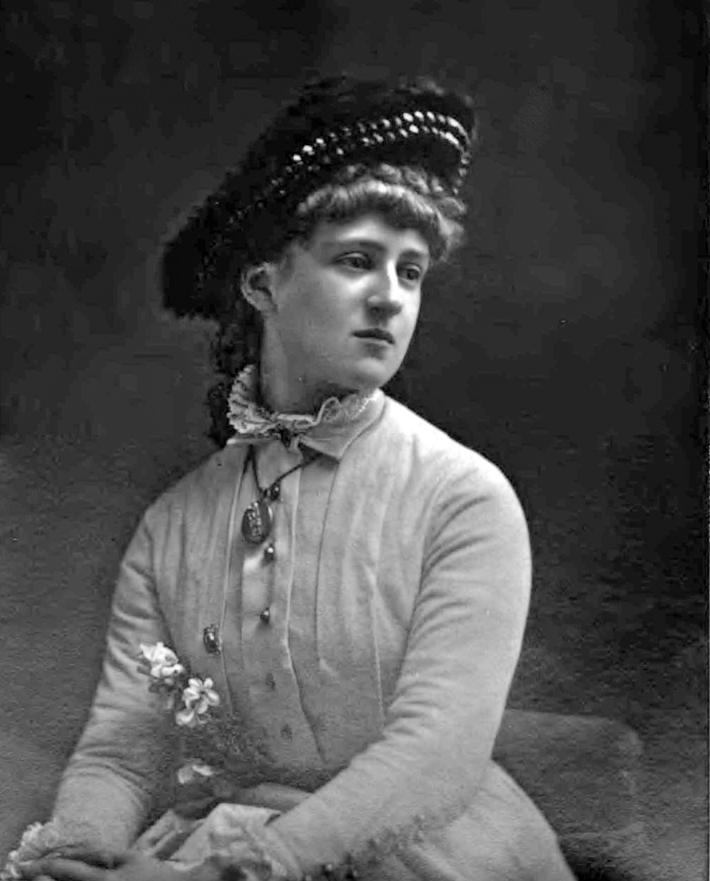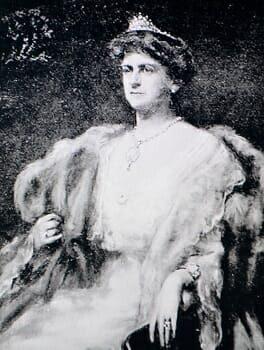The Life and Times of Elizabeth Hawkins-Whitshed
 words by Peter Murtagh
words by Peter Murtagh
Elizabeth Hawkins-Whitshed was perhaps the most extraordinary person to emerge from Greystones. She was an only child and had a very sheltered, upper middle class, upbringing at a time when children were expected to be seen and not heard, and adult woman to be gracious supporters of their husbands but otherwise to remain largely quiet and very much in the background. Elizabeth paid little attention to those Victorianconventions,however.
Instead, she became a pioneering mountaineer, scaling Alpine peaks in Switzerland and Norway, several of them never before climbed by anyone, let alone a young woman wearing a skirt. In between such adventures, she was a winter sports enthusiast, became a very accomplished photographer, wrote numerous books and marriedthreetimes.
And she was also responsible for what is her lasting legacy to Greystones -- the building of The Burnaby, the Edwardian housing estate and park developed on her lands opposite this train station. The Burnaby is reputed to be the first housing estate in Ireland and today is one of our town's Architectural ConservationAreas.
Elizabeth was born in Ireland in June 1860. Her father was Captain Sir St Vincent Hawkins-Whitshed, an officer in Britain's Royal Navy. Her mother was Alicia, formerly Alicia Handcock, and was related to the aristocratic Portland family of England. At the time of her birth, Ireland was still part of the United Kingdom and the British Empire was at the height of its global power and influence. The Hawkins-Whitsheds were partofthatworld.

Her grandfather, James Hawkins-Whitshed, was a Royal Navy admiral and at one time commander in Ireland of the Sea Fencibles (defences). In that role, he oversaw the building of Martello towers on the east coast andinCorkduringtheNapoleonicWars.
Like many others of similar standing in Ireland at that time, the HawkinsWhitsheds would have seen themselves as both Irish and British. Their home was farmland around Killincarrig village which extended right down to the sea -- and included what is now Greystones Golf Club, The Burnaby estate, and south from there, taking in Mill Road, the South Beach carpark, and the houses in Woodlands besidethenewfilmstudios.
The other great estate in the area at the time was the La Touche estate, centred on Delgany but extending also to the sea at Greystones. The boundary between the two estates was a wall, that ran along the lane known now as Burnaby Mews, and across to the train station, which was built straddling thetwoestates.
The house in which Elizabeth grew up was demolished in the 1980s to make way for Woodlands, after lying derelict for several years following a fire. It was named Killincarrig House and stood just behind Greystones Medical Centre. For a time after being Elizabeth's family home, it was a hotel -- known variously as the Clyda Hotel, the International, and finally the Woodlands. The Hawkins-Whitshed family home prior to this was Killincarrig Farm House, now partofGreystonesGolfClub.
Little is known of Elizabeth's life as a child and young adult in Greystones, but she appears to have lived happily if somewhat isolated.Thefamilyemployeddomesticstaff and, when she later went to England, Elizabeth noted that she did not know how to tie her boot laces -- someone else had alwaysdonethatforher.
In 1878, when she was aged 18, she was dispatched to London, in the hope that, in social settings appropriate to her station in life and chaperoned by Lady Porter, she would catch the eye of a suitable prospective husband. It was not long before one emerged -- Frederick Gustavus Burnaby, a British Army officer who was twice her age. They married in 1879 (her staff in Greystones sent them a wedding present) and, a year later, she gave birth to their only son, Harry, whowastobeheronlychild.
While Fred Burnaby is a minor historical figure now, at the time he was one of the most famous characters in the British Army. Swashbuckling and impetuous, he had a devil-may-care approach to life, underpinned by an iron belief in the virtues of the British Empire. He was said to be the largest man in the army, was enormously strongandwasarenownedboxer.
He was also a daring balloonist (he once ballooned across the English Channel to France), a journalist (he helped found Vanity Fair magazine), a would-be Member of Parliament (he failed to get elected), and a fighter in other people's wars (he joined the Carlist side in Spain). He could be reckless: he once rode a horse from St Petersburg to Khiva in Uzbekistan, just to see what the Russians were up to! His book about that journey, A Ride to Khiva, annoyed his superior officers but it was a best seller and causedasensationinVictorianEngland.

Soon after the birth of their son, the lives of Elizabeth and Fred diverged somewhat, partly due to his adventuring and partly due to her poor health. In 1881, she went to Switzerland on doctor's advice. There, it was hoped that the clean mountain air would benefit her lungs. Burnaby, promoted to the rank of colonel, carried on as before but in January 1885, he was killed in Sudan while trying to rescue another hero of the British Empire, General Charles George Gordon, then trapped in Khartoum and doomed to die.
In Switzerland, Elizabeth lived mostly in St Moritz,wheretheKulmHotelwasthecentre of a social whirl that was dominated by the English, among them Queen Victoria's son and heir, Edward, the Prince of Wales, and luminaries of the time such as Sir Arthur Conan Doyle, creator of the fictional detective Sherlock Holmes, and Lotte Dod, the outstanding tennis player of her day and a five times Wimbledon Ladies Lawn Tennis Champion. Elizabeth photographed them all playing winter sports in the snow and on ice and, perhaps inspired by them and the example of her late husband, she threw herselfintoanadventurouslife.
Among the St Moritz set was John Frederick Main, an American, and he and Elizabeth married in 1886. But he too had poor health and died in 1892. Elizabeth's own fragile chest did not impede her life, however. In 1900, she married, for the third and final time, Aubery le Blond, a wealthy Englishman and collector of oriental porcelain. The marriage was apparently happy, although there were no children. He and Elizabeth travelled widely, including to the Far East where le Blond acquired many items for his collection, which is now part of theVictoriaandAlbertMuseuminLondon.

Elizabeth's mountaineering feats were recognised by her Alpine climbing contemporaries. She founded the Ladies Alpine Club (which continues to this day) and her achievements inspired alpinists, men and women, then and since. During a lifelong love of photography, she took hundreds of stunning black and white pictures of winter sports pursuits in St Moritz, of challengingmountainsandofglaciers.
Shewassaidtocarryherwoodenboxcamera and tripod up the mountains with her, though it seems likely she had considerable help from guides and porters. Her climbing took her up numerous peaks in Switzerland, including one near the Matterhorn which she namedPointBurnaby,andtothefarnorthof Norway, where she photographed mountains and the Sami people of Lapland. She also took portrait photographs of her guides, including members of the Imboden family, renowned figures in the history of Alpineclimbing.
Some of her images can be seen in Greystones Library, some are with the Burnaby Residents Association but the bulk that survive, some 20,000 images, are held by the Martin and Osa Johnson Safari Museum inChanute,Kansas.



